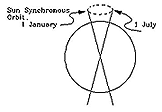|
Different types of satellite orbits have different uses: while the synchronous orbit is best for communication satellites, Lagrangian point orbits help monitor the solar wind before it reaches Earth. A low altitude polar orbit
is widely used for monitoring the Earth because each day, as the Earth rotates
below it, the entire surface is covered. Typically, a satellite in such an orbit moves in a near-circle about 1000 km (600 miles) above ground (some go lower but don't last as long, because of air friction) and each orbit takes about 100 minutes. Many spacecraft use such orbits, e.g.
the US Air Force surveillance satellites of the DMSP series, or the French
Earth-resources spacecraft SPOT.
The space shuttle avoids polar orbits, because flying through the aurora
exposes astronauts to radiation and creates other problems. But for studying
the aurora, Birkeland currents, polar rain and other phenomena related to the
distant magnetosphere, such orbits are very useful. For instance, although
the DMSP spacecraft (above) were designed for military needs, scientists have
also equipped them with magnetometers, particle detectors and other
instruments, which have provided a great amount of scientific information.
Sun-synchronous Orbits
The Earth is not an exact sphere but bulges slightly at its equator. Any orbit passing exactly above the geographic poles is symmetrically affected by the bulge and its plane stays fixed relative to the stars.
Relative to the Sun, however, the orbital plane will slowly rotate. The reason is that the Earth itself orbits the Sun, so that the Sun's position in the sky, relative to the distant stars, slowly rotates around the Earth, one circuit per year. (The 12 constellations through which the Sun passes on that journey were named by the ancients and are known as the zodiac.) If the orbital plane of the polar satellite points at the Sun now, in six months' time the Sun's motion across the sky would make it point 180 degrees from the Sun (picture below).
|

 Official GSFC Home Page
Official GSFC Home Page  NASA WWW Home Page
NASA WWW Home Page